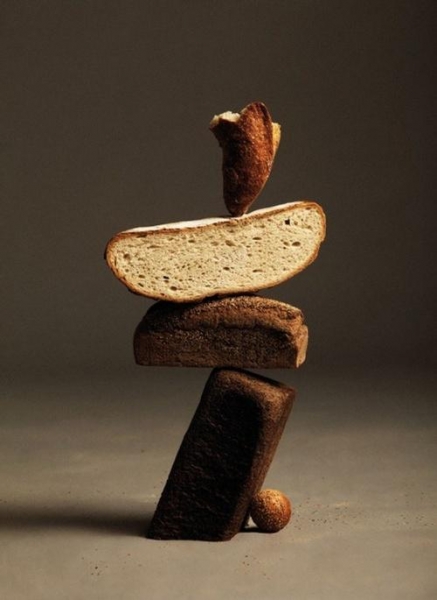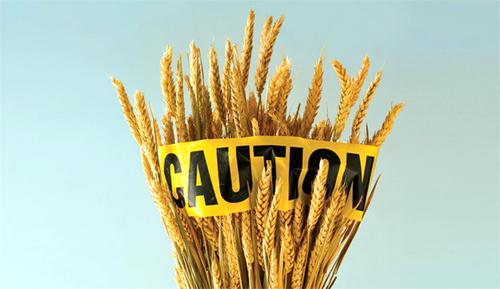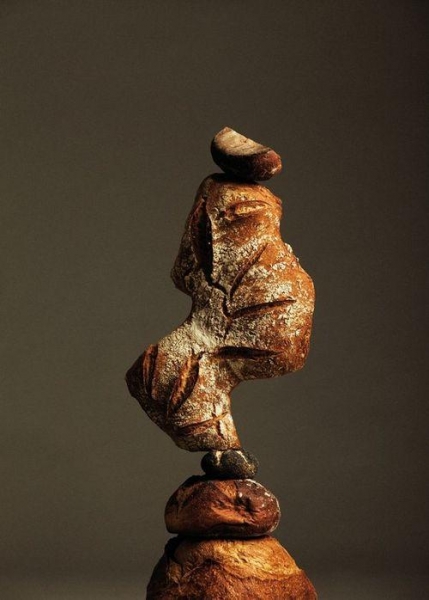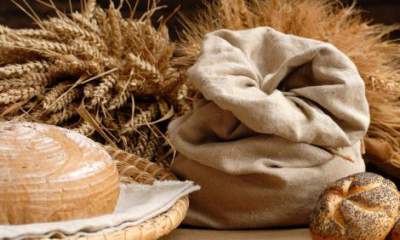Yulia Semenova

Before, I could not understand: what a strange rejection of grains? Why to stop eating oatmeal, whole wheat bread, yeast-free pita bread? “And why only people is an unnecessary restraint?” – I thought, not having, not having the right knowledge and personal experience in this matter. But over time, one reading of this wheat protein, I began to observe my feelings during and after ingestion of certain species of grasses, over and over again making sure that in addition to the pleasant sensations in the body after the beloved oatmeal, I feel the lethargy, drowsiness and some lethargy. So I watched as I tear all the brakes during lunch, when after the salad, feeling a certain saturation, I ate a couple of slices of aromatic toasted whole wheat bread with slices of avocado and spices – and my appetite flared up again: the desire to eat another 5 pieces of these sandwiches! The bread seemed incredibly delicious and inviting. The same thing I felt in relation to pizzas, noodles, and even rice with vegetables! In General, in fact, all the dishes, which was cereal.
Needless to say about the more unconscious time, when lush baguettes with garlic butter and delicious croissants with chocolate and strived to be in my hands: like most people, I just loved muffins, cookies, pasta and everything else. But now, increasingly, we see the icon of the crossed out wheat ear, inscription on the packaging “gluten free” and often encounter this phrase in articles about healthy eating. For anybody, probably not a secret that now the wave of interest in nutrition, healthy lifestyle and vegetarianism many companies (definitely not all) use all new eye-catching slogans. But it is understood that many of them intended to create the illusion of concern for the health of a person, when really it’s just a distraction from other product properties (e.g. high content of sugar or fat).
Most people not yet understand what is this mysterious gluten, where to look and why more and more companies seek to protect you from him. Also, one of the reasons my attention to gluten grains was the observation of young children of my relatives and friends, from whom I would often hear about how often began to hurt kids, and that many of them do not understand the Allergy that is caused by unknown reasons. The first thing I asked the question whether or not they eat grains, and one and all responded “Yes.” At some point, my personal experience and scientific evidence has become sufficient to is without a doubt recommended to everyone, leading a conscious lifestyle, to abandon cereals. And I suggest you to look into the matter and make its decision.

WHAT IS GLUTEN
Gluten, which translated from Latin means “glue”, is a complex protein that “glues” the grains of flour in the manufacture of bakery products. In the European Union it would seem the new word has long been known under another name gluten. When you bite into a soft muffin or stretch the pizza dough, you have to thank for this. Gluten plays a key role in the process of loosening the dough, allowing the bread to “climb” when we mix wheat flour with yeast. To see it with my own eyes, just mix the water and wheat flour, roll into a ball and then rinse it under running water to remove starch and fiber. In your hands will remain sticky mixture of proteins.
Most people consume gluten with wheat, but it contains and in many other grains, including rye, barley, spelt, Kamut, and bulgur. In addition, it is one of the most common additives used not only in food but in personal care products. As a reliable stabilizer it is used for preparation of soft cheeses, for giving smooth texture to margarine, it does not curl up sauces and gravy. Gluten is found in conditioners for hair thickening and volumizing mascara. Like any other protein, it can cause allergic reactions.
Sensitivity to gluten can cause damage in any organ, but it is not necessary to affect the small intestine, as in celiac disease. So, even if the person is not suffering from celiac disease, the body, including the brain, is in a situation of high risk.
Usually in the base of the food sensitivity is the immune system’s response to irritant. Another reason is the absence or lack in the body need enzymes digesting a particular product. In the case of gluten, its “stickiness” prevents absorb nutrients. Poorly digested food turns into a pasty substance, which irritates the mucous membrane of the small intestine. In the end you get abdominal pain, nausea, diarrhea, constipation, and other disorders. However, the intestinal symptoms were observed not at all, and their absence does not guarantee the security of other organs such as the nervous system. When the body perceives food particles as an enemy, the immune system throws at combating messengers of inflammation, including killer cells. The battle damaged the intestinal wall and develops a condition known as “leaky gut syndrome”. When antibodies of the immune system come in contact with proteins or antigens, to which I am allergic, start a cascade of inflammatory reactionsthat release a variety of chemical substances known as cytokines. Cytokines attack the brain, damage tissue and create the conditions for disease development.

CELIAC DISEASE OR GLUTEN INTOLERANCE
Celiac disease may seem “new disease”, but its the first descriptions date back to I century BC, when one of the most prominent ancient Greek physicians Area Cappadocian described this disease in a medical textbook, and reviewed all course options, including neurological disorders such as epilepsy, headache, dizziness and paralysis. Area was also the first who used the word “coeliac” which is derived from the Greek κοιλιακός — “abdominal”.
The first printed message about the disease appeared in 1908, when Dr. Christian Herter wrote a book about children with celiac disease, which he called “intestinal infantilism”. He noted that such patients are unable to develop normally and seem to tolerate fats than carbohydrates. It took another few decades, and in the forties of the twentieth century, the Dutch pediatrician Dr. Willem dike has linked celiac disease with wheat flour. By the time doctors have suspected that the problem is in the carbs but had no idea about the direct connection with the wheat. This discovery was made in 1944, during the famine in the Netherlands. The country did not have enough bread and flour, and Dr. dick noticed a sharp decline in the mortality of children with celiac disease — from greater than 35% to essentially zero. Dr. dick also reported that once wheat was again available, the mortality rose to previous levels. Finally, in 1952 a group of British doctors from Birmingham, including Dr. dick, the study of samples of intestinal mucosa obtained from surgical patients has established a link between the consumption of wheat protein and celiac disease — from greater than 35% to essentially zero. Dr. dick also reported that once wheat was again available, the mortality rose to previous levels. Finally, in 1952 a group of British doctors from Birmingham, including Dr. dick, the study of samples of intestinal mucosa obtained from surgical patients has established a link between the consumption of wheat protein and celiac disease. A biopsy of the small intestine, introduced in diagnostic practice in the 1950-1960-ies, confirmed that the target organ is the intestine and… your brain. Why? Scientists in their research came to the conclusion that gluten sensitivity, with celiac disease or no, increases production of inflammatory cytokines, which are the main factors in the development of neurodegenerative conditions, such as Alzheimer’s, multiple sclerosis and other cognitive disorders. Also use gluten products you are growing the risk of autoimmune diseases (again, largely because of the activity of cytokines), and diabetes mellitus.

THE EXCESS OF GLUTEN IN THE MODERN DIET
If gluten is so bad and we’ve used it, how we managed to survive? Response: we did not use this to gluten until our ancestors learned to grow and grind the wheat. Besides the grains we eat today bear little resemblance to the that entered our diet about 10,000 years ago. Since Gregor Mendel described his famous studies of crossing plants and of obtaining new varieties, we learned to select and mix the appropriate strains to create the right types of grains. Although genetics and human physiology has changed little since the time of our ancestors, over the past 50 years the food chain has changed considerably. Modern food production, including genetic engineering, has allowed us to grow grains that contain in withforty times more glutenthan cultivated just a few decades ago. If it is directed at increasing the yield, or matching the tastes of the people, or both — is anyone’s guess. We know one thing: modern grains containing gluten, are more addictive than ever.
If you experience a rush of pleasure, eating a bagel, scone, donut or croissant, it’s not your imagination. Since the late 1970s, we know that the stomach gluten breaks down into a mix of polypeptides that can cross the blood-brain barrier (semi-permeable barrier between blood and nerve tissue, preventing the penetration into the brain chemical compounds and a variety of harmful agents).
Entering, they bind to the opiate receptors in the brain and cause a feeling of pleasure. These are the same receptors that bind opiates to create a pleasant, albeit addictive effect. For the first time this effect was discovered by Dr. Cristina Sidru and her colleagues from the National Institute of health, USA. They called the polypeptides with exogenous morphine-like compounds, or in short entryname (produced by the body’s natural painkillers called endorphins). The most interesting thing in assorting, and this once again confirms their influence on the brain that they can “turn off” a drug that blocks the action of opiates.
Given the above, is it any wonder that manufacturers are trying to push the products as much gluten? And is it any wonder that there are so many people experiencing addiction to foods filled with gluten, not only inciting the flames of the inflammation but also causing the obesity epidemic?
I think not. Everyone knows that sugar and alcohol creates a feeling of well-being and tempting to go back and repeat. But what about foods containing gluten, such as whole-wheat bread and instant oatmeal? The idea that gluten can cause fun and addictive, it seems strange. And scary. If gluten really is a psychotropic substance, and science proves it to be so, we need to re-evaluate the products with its contents and their place in our diet.

Watch how people eat gluten is overloaded with carbs is like watching someone pouring themselves a cocktail of gasoline. Gluten is the tobacco of our generation. Not only that sensitivity to gluten is far more widespread than you think, it’s almost all causes of potential harm and hides where you least suspect. Gluten is contained in condiments, ice cream and even cosmetics. It’s disguised in soups, sweeteners and soy products. He hides in food supplements and branded drugs. The term “gluten-free” becomes so vague and diluted, as “organic” and “natural”.
Over millions of years the diet of our ancestors consisted of wild game, seasonal vegetables and sometimes berries. Today, the diet of most people is based on grains and carbohydrate-rich foods, many of which contain gluten. And it’s not just him. The use of such large quantities of grains and carbohydrates causes a much greater increase in blood sugar than other natural products.
And this, in turn, affects the production of insulin. The higher the sugar level, the more of this hormone is required. But the more insulin, the lower the sensitivity of cells to his signal. In order to force the cells to react, the pancreas works overtime, increasing insulin production, to continue to maintain the necessary balance of blood sugar. And although he remains normal, the insulin level grows. The result is a stalemate: the pancreas cannot produce more insulin, and what it produces, is not enough. At this point, cells eventually lose their ability to respond to the signal of insulin and develop diabetes of the 2nd type. However, don’t have to be diabetic to suffer from chronic high blood sugar.

SIGNS OF SENSITIVITY TO GLUTEN
Here is a list of symptoms and diseases associated with celiac sensitivity. If you or your relatives have any of the list – eliminate gluten-rich foods from your diet and you’ll feel better in a few weeks.
-
Digestive disorders (gas, bloating, diarrhea, constipation, cramps, etc.).
-
The irritable bowel syndrome.
-
Malabsorption of food.
-
Nausea / vomiting.
-
Delay growth.
-
Hives / rash.
-
Confusion.
-
Neurological disorders (dementia, Alzheimer’s disease, schizophrenia, etc.).
-
Seizures / epilepsy.
-
Ataxia, loss of balance.
-
Constant illness.
-
The pain in his chest.
-
Intolerance to dairy products.
-
Cravings for sweet foods.
-
Bone pain / osteopenia / osteoporosis.
-
Heart disease.
-
Alarm.
-
Depression.
-
ADHD.
-
Infertility.
-
Miscarriages.
-
Migraine.
-
Autism.
-
Alcoholism.
-
Cancer.
-
Parkinson’s Disease.
-
BASS.
-
Autoimmune disorders (e.g., diabetes, Hashimoto’s thyroiditis, rheumatoid arthritis).
NOW WHAT IS
Most people are very accustomed to the constant consumption of wheat flour products, oats, rye, pasta and pizza, cake and donuts. But if you want to feel more energy, keep your body in good condition as long as possible and to raise healthy children, this bad habit should be overcome. And these materials will help you to do it!
Understand that actually to abandon cereals is not so difficult that you’ll be able to eat in the city, but will simply act more consciously. The demand creates the market, and the increasing number of conscious people, the range of shops and restaurants will gradually change to satisfy the needs of customers. Only ceasing to resist the temptations of cities, we will be able to enter a new phase of more happy, healthy and conscious living to all people )
THE FOLLOWING PRODUCTS CONTAIN GLUTEN
-
wheat and germ, all kinds of products from white flour: bread, pita, crackers, drying pasta, biscuits etc. (the same spravidlivo and for rye, barley, etc.)
-
wheat flour;
-
oats
-
rye;
-
Kamut;
-
barley;
-
bulgur;
-
semolina;
-
couscous;
-
spelt.
THE FOLLOWING GRAINS AND STARCHES CONTAIN GLUTEN:
-
buckwheat;
-
Fig;
-
corn;
-
sorghum;
-
millet (millet);
-
soy;
-
potatoes;
-
tapioca;
-
quinoa (quinoa);
-
amaranth;
-
metlicka Abyssinian.
THE FOLLOWING FOODS OFTEN CONTAIN GLUTEN:
-
malt / malt extract;
-
prepared soups, broths (liquid or cubes);
-
meat products;
-
French fries (which are often sprinkled with flour before freezing);
-
cream cheese, blue cheese;
-
mayonnaise;
-
ketchup;
-
soy sauce and teriyaki sauce;
-
salad dressings;
-
marinades;
-
imitation crab meat;
-
sausage;
-
sausages;
-
non-dairy creamer;
-
the chocolate milk;
-
fried vegetables / tempura;
-
canned baked beans;
-
cereals;
-
breaded products;
-
fruit fillings and puddings;
-
ice cream;
-
energy bars;
-
syrups;
-
instant hot beverages;
-
flavored coffee and tea;
-
oat bran;
-
roasted nuts;
-
beer;
-
vodka.
OTHER SOURCES OF GLUTEN:
-
shampoos and other cosmetics, including lipsticks, lip balms, medicines, vitamins and supplements (check the label).
GLUTEN CAN BE ENCRYPTED UNDER THESE NAMES:
Many companies are now trying to hide the use of gluten grains in their products, so it’s best just to avoid proizvodstva industrial products with complex structureor try to test them (of course without being eco-crazy).
-
Avena sativa (oats seed).
-
Hordeum distichon (two-rowed barley).
-
Hordeum vulgare (common barley).
-
Сereale Secale (rye).
-
Triticum aestivum (soft wheat).
-
Triticum vulgare (common wheat).
-
Cyclodextrin.
-
Dextrin.
-
Fermented grain extract.
-
Hydrolysate.
-
Hydrolyzed malt extract.
-
Hydrolyzed vegetable protein.
-
Maltodextrin.
-
Extract fitotehnie.
-
Amino-peptide complex.
-
Tocopherol / vitamin E.
-
Yeast extract.
-
Natural flavoring.
-
The brown rice syrup.
-
The modified food starch.
-
Hydrolyzed vegetable protein (GRB).
-
Hydrolyzed protein.
-
Caramel color (frequently made from barley).
SUMMARY
-
gluten is addictive
-
gluten makes you eat more than you need actually
-
gluten causes multiple violations of the functioning of the body, which are based on poor absorption of nutrients and as a consequence inflammation
-
gluten makes you more sluggish and lazy
If you want to feel better and to keep such feelings until old age, if you want to deprive yourself of the risks of diabetes, diseases of the gastrointestinal tract, brain, and other systems, if you want to minimize the number of colds, allergies and other seasonal diseases — give up the gluten! It is not difficult. Around the world millions of people already gave up wheat, now it can make you.
You will feel great, changing your eating habits, entering into your diet more fruits, greens, vegetables and pseudosecular (such as buckwheat, millet and quinoa). A lot of people free from their diseases just abandoning the gluten!
Understand that corporations keep their customers, due to the fact that people just don’t know that gluten is addictive (especially when combined with sugar and fat), and forcing them to buy familiar food again and again inevitably leads to various diseases. We can be more aware, alert and healthy, freed from immersing us in a dream spell by ears of wheat. Let’s do this step!
The article is based on materials from the book by David Perlmutter “Food and the brain”, in which you can learn even more about what carbs do to our body and especially the brain, BUT! ATTENTION, I do NOT share the author’s point of view about the type of food that he offers in his work, about which I already wrote here. Be healthy, live more and more consciously!








